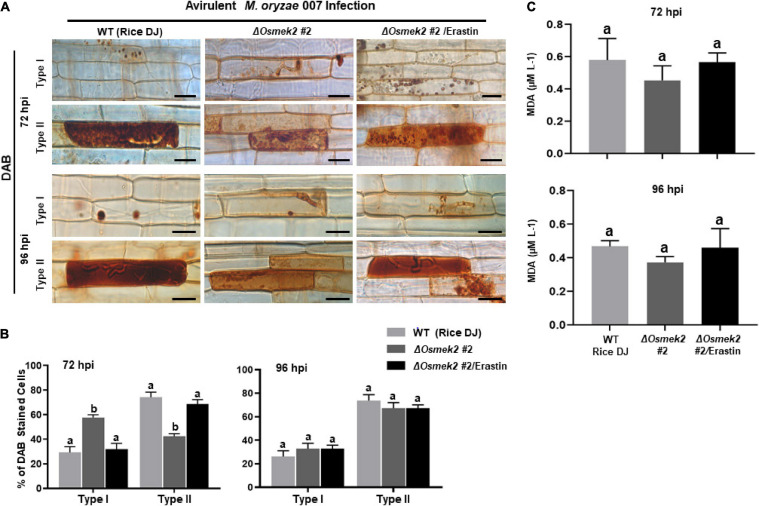FIGURE 8.
ROS accumulation and lipid peroxidation in leaf sheaths of wild-type (WT) rice (cultivar DJ) and ΔOsmek2 #2 plants at 72 and 96 h after inoculation with avirulent Magnaporthe oryzae 007 with 10 μM erastin. Rice ΔOsmek2 #2 leaf sheaths were inoculated with conidial suspensions (4 × 105 conidia mL–1) of avirulent M. oryzae 007 with and without 10 μM erastin. Avirulent M. oryzae 007 infection induced ROS production and lipid peroxidation in leaf sheaths of the susceptible ΔOsmek2 plants at 96 hpi, which was similar to those in erastin-treated leaf sheaths of the susceptible ΔOsmek2 #2 plants. (A) DAB-stained cell phenotypes at 72 and 96 h after inoculation. DAB-stained cells were categorized into two phenotypes: Type I, cells that contain invasive hyphae (IH) but are weakly or not DAB-stained; and Type II, strongly DAB-stained cells with only a few poor hyphae. Scale bars = 20 μm. (B) Quantification of DAB-stained cells at 72 and 96 h after inoculation. DAB-stained cells were categorized into two phenotypes: Type I, infected cells that display no or weak DAB staining; Type II, infected cells that display strong DAB staining. (C) Determination of lipid (MDA) peroxidation in rice leaf sheaths at 72 and 96 h after inoculation. Results are presented as mean values ± SD; n = 4 leaf sheaths from different plants. Images were captured using a fluorescence microscope (Zeiss equipped with Axioplan 2). Results are presented as mean values ± SD; n = 4 leaf sheaths from different plants. Different letters above the bars indicate significantly different means (P < 0.05) as analyzed by Fisher’s protected LSD test. Experiments were repeated three times with similar results. hpi, hours post-inoculation.

